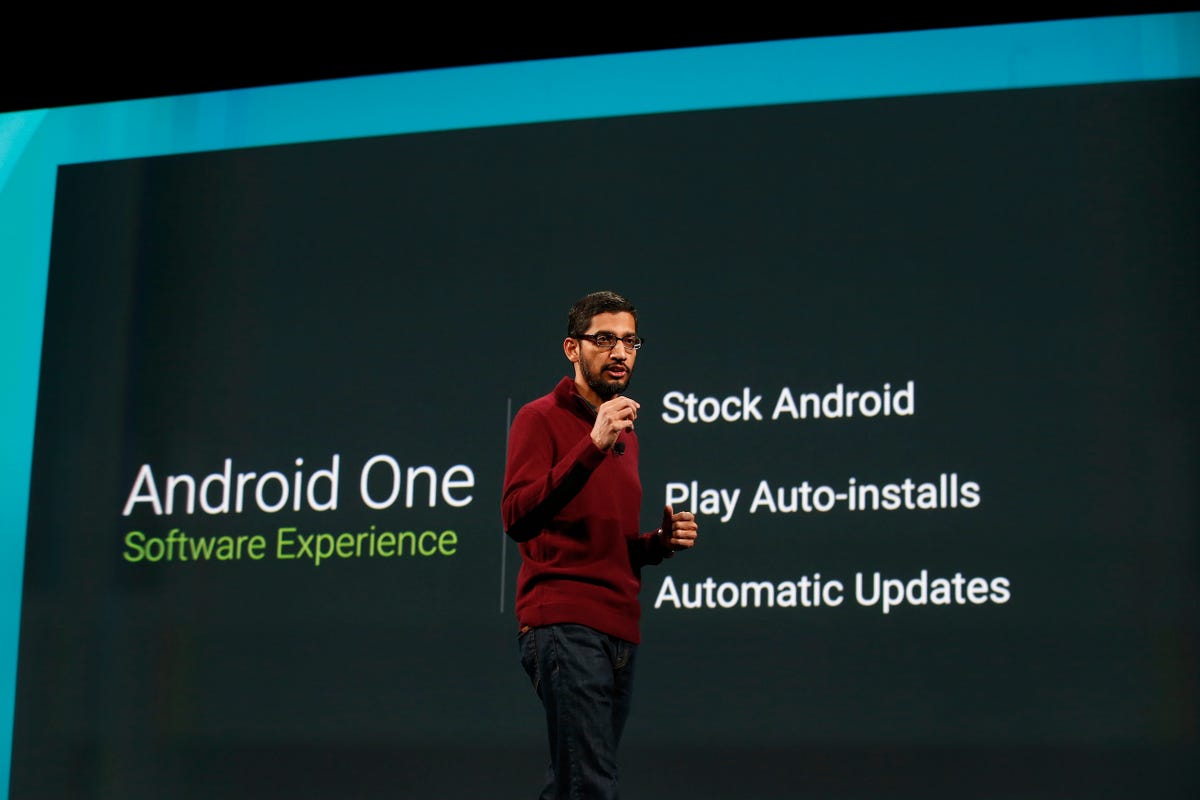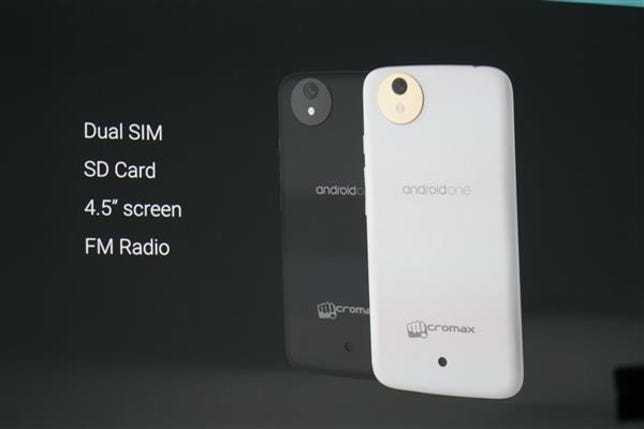
Getty Images
Google just took an important step toward cementing its dominance over the world with its Android mobile operating system.
In the wee hours of the morning on Monday, almost 8,000 miles away from its headquarters in Mountain View, Calif., Google launched its Android One initiative in New Delhi, India. The project, originally announced at the company’s I/O conference in June, is essentially a way for Google to guide handset manufacturers in bringing affordable smartphones to emerging markets.
The initiative is designed both to reduce the ultimate price tag of Android smartphones, giving more budget-conscious consumers a chance to try out the devices, and to bring a more consistent Android experience, ensuring that those consumers are using Google services. That the Internet giant is making so much noise out of Android One underscores the importance of those markets, which are a critical source of future user growth — and where Google isn’t the only company looking to plant its flag.
Android One is first rolling out in India, then in Indonesia, the Philippines and South Asia by the end of the year. For the launch, Google has partnered with three Indian device makers — Micromax, Karbonn and Spice — to create three $100 smartphones, as well as teamed up with the wireless provider Bharti Airtel, the largest mobile carrier in India, with 40 percent of smartphone users in the country on that network.


Phones made under the Android One rubric will also run “stock” Android, an unmodified version of the software, without the technical and user interface flourishes that manufacturers such as Samsung or HTC typically add to make their smartphones stand out from the competition. The company has already designed its most current version of Android, called KitKat, to run on low-cost hardware.
The three new handsets are the Spice Android One Dream UNO Mi-498, the Micromax Canvas A1 and the Karbonn Sparkle V. Google on Monday also announced additional hardware partners, including Asus, HTC, Lenovo and chipmaker Qualcomm.
At launch, the phones incorporated similar specifications — 4.5-inch FWVGA display with a 854×480-pixel resolution, quad-core 1.3GHz MediaTek processor, dual-SIM capability, 1GB RAM and 4GB of onboard storage alongside a microSD card slot for expandability. There’s a rear 5-megapixel camera and a removable 1,700mAh battery as well.
“With Android One, we not only want to help people get online, we want to make sure that when they get there, they can tap into the wealth of information and knowledge the web holds for everyone,” said Sundar Pichai, Google’s senior vice president of Android, Chrome, and apps, in a blog post.
“The expectation of the user has changed,” said Anand Chandrasekaran, Bharti Airtel’s chief product officer, in an interview. “In terms of what they consider a feature-rich phone — and what they are willing to pay for it.”
One of the major problems that the initiative addresses, besides the cost of hardware components, is out-of-date software. In India, where most data plans are prepaid, users tend to ignore updating their operating systems and apps because auto-update features usually eat through much of their plans, Chandrasekaran said. Many just disable those features and carry on with old software. “Users end up using 40 to 50 percent of their data plans on updates they don’t know about,” said Chandrasekaran. “So they turn it off.”


CNET
The carrier will allow users to download Android updates free of charge for the first six months, as well as 200MB worth of apps — which won’t count against their their monthly data intake.
By the end of the year, 1.75 billion people worldwide will own smartphones, according to eMarketer. Among those already wielding the gadgets, Google has a sizable lead. Android has 1 billion active users, Pichai said in June, and its devices make up 80 percent of the global market. Apple’s iOS, which powers iPhones and iPads, accounts for 17 percent.
Google wants to make sure that when the rest of the population buys their first smartphones — mostly in the developing world — they go with Android. “We can get the next billion people onto these devices,” said Pichai, introducing the Android One initiative at the I/O conference. On Monday, Pichai upped his goal, noting that Android One was “for the next five billion.”
The company did not make any of its employees available for this story.
Mission: Connection
As business operations go, the initiative is in line with Google’s — and several other tech giants’ — long-term strategy: connect as many users as possible. That way, the company can get its software and services to an even wider an audience. Taking that idea even a step further in the pipeline, Google has made major investments in first bringing Internet access to unwired populations. Project Loon, an initiative run through the company’s ambitious Google X division, aims to beam Wi-Fi to rural regions via high-altitude balloons. The company has also reportedly committed more that $1 billion to satellites that will do the same kind of thing.
Facebook has similar plans: the company has tinkered with satellites and drones to deliver people Internet access, through an effort called Connectivity Labs. And CEO Mark Zuckerberg has been an ardent supporter of affordable web connectivity through an initiative called Internet.org.
But the most straightforward approach, for now, is smartphones. Microsoft has similar smartphone designs on developing markets. Over the last seven months, the software titan has eliminated fees for its Windows Phone, struck deals with some of the same low-cost manufacturers — such as Micromax — and worked with Qualcomm for low-cost chips and reference designs to enable more affordable smartphones. Microsoft’s Lumia line, formerly created by Nokia, had already seen a bulk of it success from emerging markets.


In India, Samsung — which runs a modified version of Android on its phones — is the handset leader. The top smartphone in the country is the Galaxy Star Pro, which sells for $76, according to IDC. The manufacturer’s No. 2 and 3 models are the $130 S2 and the $297 Grand 2. Other companies have also made recent plays in the low-end market. Firefox makes a smartphone that sells for $33. And the Chinese company Xiaomi sells a $100 Android smartphone that sold out in India earlier this month in less than 5 seconds, claimed CEO — and former Android vice president — Hugo Barra.
Part of the goal, Chandrasekaran said, is to entice people who would have normally bought feature phones to instead go for smartphones — where they’ll consume three to five times more data on average, according to Airtel’s findings.
“For someone who barely used data to now using 500 percent more, that’s a huge moment,” he said.
Android One, one Android
While Android has a dominant grasp of the market, one knock competitors like Apple always mention is that the software’s ecosystem is fragmented. Because it’s an open platform, meaning anyone can use and adapt it, hardware partners like Samsung have modified it to fit their needs, leaving users and software developers to wade through Android’s many iterations.
But the very name Android One — and Google’s rule that hardware partners run stock Android — seems to suggest the company wants to home in on a more consistent experience. Onstage at I/O, Pichai emphasized that all the software on Android One comes from Google.
“Google has been quietly clamping down on OEMs [or hardware manufacturers] from making things too custom,” said Melissa Chau, an analyst at IDC, who covers the smartphone market in Asia.
Google’s main play here, though, is reeling in manufacturers who are using Android, but are not certified for Google Mobile Services, or Google apps like Maps or Search, said Chau. “They want to make sure, if you’re buying a $100 phone, you’re actually using Google services,” she said. “They’re trying to clean out all that super fragmented stuff.”
The company has also been aiming toward more uniformity with other Android projects. For Android Wear — a modified version of the operating system tailor-made for wearable devices like smartwatches — software updates come more directly from Google, instead of first having to be tested by carriers. That’s because smartwatches typically must be connected to smartphones, so carriers are not involved. (Though an exception is Samsung’s Gear S watch, which has a built-in modem.)
India or bust
The launch in India also marks a big push by Google in the second most populous country in the world after China.
The country will have 90 million smartphone users by the end of the year, said Chandrasekaran. There also are some unique broadband challenges in that country. Because networks are less built out, the total amount of Web capacity is smaller. “In some sense, it’s hitting the laws of physics,” said Chandrasekaran. Also, unlike in the US, where 4G cellular networks are used mainly for smartphone service, people in India also use 4G as a Wi-Fi hub, which puts more pressure on the network.
Related Stories
- Google spells out ambitious plan: Android world domination
- Google’s Android Wear team: We’ll update early and often
- Larry Page’s stamp on Google: More than moon shots
As Google adapts its services for a more global audience, it’s also looking at how different localities use the products. The company last month rolled out a feature in Google voice search that lets someone who speaks more than one language ask a question in multiple tongues, without having to change the setting on the app.
Chandrasekaran, who lived in Silicon Valley for several years as Yahoo’s senior director of search products, noticed one thing immediately about his phone after he moved back to his native India in April. “When I used Google Maps for the first time, the voiceover had an Indian accent,” he said, laughing.
“This is recognition of India as an important market,” he added, of the launch.
For Pichai, who was also born in India, the choice of the launch country may also have a personal pull. “When I go back home to India and other countries like that, it is exciting to see the impact of phones on people’s lives,” he said at I/O. “But it’s disappointing that only less than 10 percent of the population has access to smartphones.
“We want to change that.”



